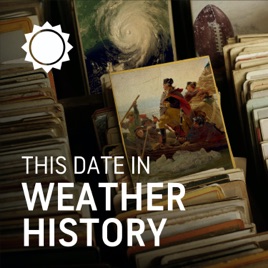
Advertise on podcast: This Date in Weather History
Rating
4.9 from
Categories
Country
This podcast has
779 episodes
Language
Publisher
Explicit
No
Date created
2020/02/03
Average duration
3 min.
Release period
2 days
Description
In this daily podcast, you’ll learn something new each day. AccuWeather Meteorologist, Evan Myers takes a look back on weather events that impacted this date in the past, uncovering history that were shaped by unbelievable weather conditions. See acast.com/privacy for privacy and opt-out information.
Podcast episodes
Check latest episodes from This Date in Weather History podcast
This Date in Weather History Update
2022/06/17
This Date in Weather History podcast update from AccuWeather.
See acast.com/privacy for privacy and opt-out information.
2014: Hail storm causes $400 million in damage in Abilene, TX
2022/06/12
On June 12, 2014 a hail storm that hit Abilene produced more than $400 million in insured losses to vehicles, homes and commercial property. "This is the worst storm damage I've seen in my 41 years in the insurance business," Leroy Perkins of the Perkins Insurance Agency in Abilene, told the largest state insurance trade association in the United States. the storm, packing baseball-sized hail, moved directly south across Abilene pounding the city's north side and downtown area. Commercial buildings downtown received millions of dollars in damage to roofs, windows and structures. Total uninsured losses are also expected to be high, Perkins adds. "Downtown looks like autumn because all of the trees have been stripped of their leaves and many limbs down in the street," Karla Martin with the Taylor County Sheriff's Office said the day after the storm. Hundreds of vehicles, many of them new cars, were declared totaled from the beating they took. The National Oceanic and Atmospheric Administration (NOAA) notes that hail causes approximately 1$ billion in damage to crops and property each year.
See acast.com/privacy for privacy and opt-out information.
more
2008: F3 tornado strikes Scout camp near Little Sioux, IA
2022/06/11
June 11, 2008 marks the tragic loss of 4 teenagers at a Boy Scout camp near Little Sioux, Iowa; 48 more were injured. The tragedy struck at the 1,800-acre camp about an hour north of downtown Omaha. An EF3 tornado, with 145 mph winds, descended on the remote camp, striking and leveling a cabin where campers had sought shelter as warnings of the storm circulated through the camp. A chimney at the cabin collapsed, sending heavy concrete blocks onto the Scouts. This was the worst of the storms that hit the Northern Plains that day. There were also two farms damaged from two different tornadoes, one near Spencer, Iowa and the other near Springfield, Minnesota. A nursing home was also damaged by a tornado in southern Salina, Kansas. There were over 300 reports of severe weather across the nation with 64 of those reports from tornado activity. There had been no basement or in-ground shelter at the camp when the tornado hit. The following year, the Boy Scouts Mid-America Council launched a major fundraising campaign to build emergency shelters at all of its camps. By 2013, two tornado shelters had been built at the camp, and a siren was added. The new structures have concrete walls, steel shutters and doors and emergency power backup, and were built to withstand an EF5 tornado.'
See acast.com/privacy for privacy and opt-out information.
more
1752: Benjamin Franklin famously flies kite in thunderstorm
2022/06/10
Benjamin Franklin, inventor of bifocal glasses, the Franklin stove, one of those that wrote the Declaration of Independence and the Constitution, ambassador, Governor of Pennsylvania, on June 10 1752 in Philadelphia, flew a kite during a thunderstorm and collected an ambient electrical charge in a Leyden jar, enabling him to demonstrate the connection between lightning and electricity. According to the Franklin Institute, Franklin had been waiting for an opportunity like this. He wanted to demonstrate the electrical nature of lightning, and to do so, he needed a thunderstorm. He had his materials at the ready: a simple kite made with a large silk handkerchief, a hemp string, and a silk string. He also had a house key, a Leyden jar (a device that could store an electrical charge for later use), and a sharp length of wire. His son William assisted him. Franklin had originally planned to conduct the experiment atop a Philadelphia church spire, according to his contemporary, British scientist Joseph Priestley (who, incidentally, is credited with discovering oxygen), but he changed his plans when he realized he could achieve the same goal by using a kite. Franklin and his son “took the opportunity of the first approaching thunder storm to take a walk into a field,” Priestley wrote in his account. “To demonstrate, in the completest manner possible, the sameness of the electric fluid with the matter of lightning, Dr. Franklin, astonishing as it must have appeared, contrived actually to bring lightning from the heavens, by means of an electrical kite, which he raised when a storm of thunder was perceived to be coming on.” Despite a common misconception, Benjamin Franklin did not discover electricity during this experiment—or at all, for that matter. Electrical forces had been recognized for more than a thousand years, and scientists had worked extensively with static electricity. Franklin’s experiment demonstrated the connection between lightning and electricity. To dispel another myth, Franklin’s kite was not struck by lightning. If it had been, he probably would have been electrocuted. Franklin became interested in electricity in the mid-1740s, a time when much was still unknown on the topic, and spent almost a decade conducting electrical experiments. He coined a number of terms used today, including battery, conductor and electrician. He also invented the lightning rod, used to protect buildings and ships. By the time he died in 1790 he was arguably the most famous man in the world.
See acast.com/privacy for privacy and opt-out information.
more
1984: Violent tornado outbreak in Russia
2022/06/09
The tornado outbreak of 9 June 1984 is among the most important tornado events in Russia’s history because it was associated with substantial loss of life with 400 deaths, and contained one of two F4 tornadoes ever recorded for in that country. Very little information is available on a violent tornado outbreak that swept through areas north of Moscow in the summer of 1984. The Soviet Union had not yet disbanded and few details were leaked to the international media. The outbreak was the result of a series of violent supercell thunderstorms that travelled north-northeast at speeds greater than 50mph. Local newspapers reported that massive hailstones, some over 2lbs in weight, fell over the affected areas. 400 people were killed, with most of the fatalities likely the result of a single tornado that tore through the town of Ivanovo. A French research article describes how the tornado threw cars long distances, lifted a 350-ton operating crane and leveled “steel-reinforced” buildings. According to the same article, the Russians unofficially awarded the tornado an F4 rating, although some of the damage was indicative of F5 strength. Reports describe how the tornado scoured pavement from a highway and hurled a 120,000lb water tank several blocks. Satellite images at the time showed an strong severe weather set up reminiscent of large outbreaks in tornado alley in the US. If the reports are all true, then the outbreak was an unprecedented event and astoundingly violent for an area generally accustomed to tornadoes only capable of inflicting F1 and F2 damage.
See acast.com/privacy for privacy and opt-out information.
more
The 1953 Flint–Worcester tornado outbreak
2022/06/08
The 1953 Flint–Worcester tornado outbreak was a devastating tornado outbreak sequence spanning three days, two that featured tornadoes each causing at least 90 deaths—an F5 occurring in Flint, Michigan on June 8, 1953, and an F4 in Worcester, Massachusetts the next day. The Worcester storm stayed on the ground for nearly 90 minutes, traveling 48 miles across Central Massachusetts. In total, 94 people were killed, making it the 21st deadliest tornado in the history of the US. In addition to the fatalities, over 1,000 people were injured and 4,000 buildings were damaged. The tornado caused $52 million in damage, which translates to more than $350 million in today’s dollars. These tornadoes are among the deadliest in U S history and were caused by the same storm system that moved eastward across the nation. The tornadoes are also related together in the public mind because, for a brief period following the Worchester tornado, it was debated in the U.S. Congress whether recent atomic bomb testing in the upper atmosphere had caused the tornadoes. Congressman James Van Zandt (R-Penn.) was among several members of Congress who expressed their belief that the June 4th bomb testing created the tornadoes, which occurred far outside the traditional tornado alley. They demanded a response from the government. Meteorologists quickly dispelled such an assertion, and Congressman Van Zandt later retracted his statement.
See acast.com/privacy for privacy and opt-out information.
more
1984: F5 tornado destroys 90% of Barneveld, WI
2022/06/07
On June 7 1984, nine people died and 200 were injured when a tornado slammed into the Iowa County, Wisconsin community of Barneveld. The F5 twister destroyed 90% of the town of 580 residents. What made Barneveld’s tornado rare is it hit overnight. A majority of tornadoes occur between 3 and 9 p.m., and violent tornadoes almost never happen late at night. Many tornadoes show a telltale “hook” shape on radar, but Barneveld’s tornado did not. Meteorologists could see fast-moving storms on radar heading northeast through Grant and Lafayette counties but without the hook, they did not know a tornado was forming. Most people in Barneveld were in bed and didn’t know about the warning unless they happened to be watching television and saw the scrawl on their TV screens. Because power went out a few minutes before the twister hit, Barneveld’s tornado siren never sounded. Lightning flashed so often — more than 200 strikes per minute — that the sky looked like a strobe light, according to the National Weather Service in Madison. The tornado traveled 36 miles for 59 minutes. At its peak, it was nearly a quarter-mile wide. Destroyed were all three of Barneveld’s churches, 93 homes, 17 of the community’s 18 businesses including the library, fire station, bank, post office and municipal building. Barneveld’s water tower was marked by blue paint about halfway up, possibly from a twirling car. A couple sleeping on the upper floor of their house ended up in the basement with their truck on top; they survived. Paper debris including checks, letters, bills and invoices in an area 23 miles wide and 110 miles away.
See acast.com/privacy for privacy and opt-out information.
more
1944: How weather forecasting impacted D-Day
2022/06/06
The story of how weather forecasting impacted the Allies invasion of Normandy on D-Day in 1944.
https://www.accuweather.com/en/weather-news/d-day-anniversary-how-the-weather-forecast-changed-the-tide-of-war/359733
See acast.com/privacy for privacy and opt-out information.
more
1925: Temperature reaches 100 degrees in Washington DC
2022/06/05
Rainfall totals in the northeastern United States from January through the end of May 1925 had only reached half the normal total in most cities. This meant, at least for the first 5 months of the year the climate was more like patched central Texas than the lush and green landscape of the eastern seaboard. Heating of the lower atmosphere takes place when the ground is heated and transfers that heat to the air closest to the ground. When the ground is moist some of the sun’s energy goes into evaporating the moisture rather than heating the ground. When the ground is dry that doesn’t happen and the ground heats up quickly. It’s one reason why it’s so much hotter in Texas and New Mexico and Arizona then the East. An unusual warm air mass moved over the eastern part of the nation in the first week of June 1925 and that coupled with the already dry ground lead to extraordinary early summertime heat. On June 5 the mercury reached 100 in Washington DC – the earliest on record in fact that was in the middle on a string of high temperatures in DC that reached 97 or higher for 5 consecutive days.. On June 5 1925 Philadelphia also reach 100 for the earliest ever there as well.
See acast.com/privacy for privacy and opt-out information.
more
1976: Strong tropical cyclone and 40' storm surge hits India
2022/06/04
On June 4, 1976 a strong Tropical Cyclone, known in the US as a Hurricane, hit the port cities just north of Mumba on the west coast of India. In the decades prior to the storm, massive Tropical Cyclones has battered both the west and east coasts of India with huge waves and heavy rains resulting in massive flooding and tremendous loss of life. Along the Indian east coast, especially in the northern part of the Bay of Bengal, the area is flat, almost at sea level for hundreds of square miles and ocean water is often pushed far inland because of the flat land. Significant warning times are needed to evacuate people out of harm’s way. Prior to the late 1960s and early 1970’s and the advent of satellite coverage very little warning lead time occurred. But by 1976 new technology had allowed for enough notice, in certain situations, for people to get out of the way. On June 4, 1976 despite a 40-foot storm surge ample notice was given and most people were able to evacuate, despite this 70 people still perished.
See acast.com/privacy for privacy and opt-out information.
more
1921: Cloudburst causes 10' of flooding in Pueblo, CO
2022/06/03
What started out as just another day in June in Colorado in 1921, rapidly turned into one that would never be forgotten in the town of Pueblo, Colorado. A cloudburst enveloped the town the afternoon of June 3, 1921. During a typical cloudburst, over half an inch of rain may fall in a matter of minutes, and that is exactly what happened in Pueblo, creating devastating consequences for the heart of the town where the Arkansas River and Fountain Creek meet. At about the same time the rains were drenching the downtown area, there was another downpour about 30 miles north over Fountain Creek. As the torrential rains fell, the Arkansas River and Fountain Creek quickly began to swell, reaching over 15 feet in some areas before they began to recede. Within two hours from the start of the storm, the business district of Pueblo was flooded with water 10 feet deep. The entire Arkansas Valley, from 30 miles west of Pueblo to the Colorado–Kansas state line, was severely impacted. Hundreds of people died, with some death toll estimates as high as 1,500. The flood destroyed almost all of the downtown Pueblo area and decimated the city. Once the floodwaters receded, the immense damage became all the more visible. The flood, which covered over 300 square miles, carried away over 600 homes and caused upward of $25 million $350 million in 2021 dollars. Railroad passenger coaches and freight cars were swept away in every direction or smashed. A fire broke out in a lumberyard and burning lumber was carried throughout the city’s streets by the flood. The floodwaters also carried away entire buildings and businesses. Many of the dead were likely carried far down river and never recovered.
See acast.com/privacy for privacy and opt-out information.
more
1889: Flooding of the Potomac River
2022/06/02
On June 2, 1889, the same heavy rains caused that had helped cause massive flooding in Johnstown, Pennsylvania, overwhelmed the South Fork Dam several days before, hit the Washington, DC, area. Most of the roads in DC at the time where unpaved and unlike some other major cities of the time not even covered in cobblestones, their surface consisted mainly of dirt. As a result, when the Potomac River flooded and areas around Pennsylvania Avenue and the White House the whole region was under several feet of water the flooding was made worse by sewers that became clogged with dirt from unpaved roads and began overflowing, causing the water to rise faster than expected. The water on city streets because so deep that the only access between the east and west of the city was by boat.
See acast.com/privacy for privacy and opt-out information.
more
Podcast reviews
Read This Date in Weather History podcast reviews
WyattMute
2020/06/19
No adverse weather....
Great idea!
Podcast sponsorship advertising
Start advertising on This Date in Weather History & sponsor relevant audience podcasts
You may also like these history Podcasts

4.9
330
145
Uncanny Japan - Japanese Folklore, Folktales, Myths and Language
Uncanny Productions

4.8
2847
278
GraveYard Tales
Adam Ballinger & Matt Rudolph

4.6
14077
294
Throughline
NPR

4.7
12815
176
Noble Blood
iHeartPodcasts and Grim & Mild

4.7
3428
600
Hillbilly Horror Stories Paranormal Podcast
Jerry & Tracy Paulley, Kentucky, Florida, Paranormal, Scary, Ghosts, Horror, Supernatural, Lore, Unexplained, Cryptids, UFO, Spooky, Bigfoot, Sasquatch

4.6
1457
680
History Daily
Airship | Noiser | Wondery

4.6
8233
121
On the Media
WNYC Studios

4.2
3271
775
Real Ghost Stories Online
Real Ghost Stories Online | Paranormal, Supernatural & Horror Radio

4.2
4102
685
Ridiculous History
iHeartPodcasts

4.9
363
34
Headwaters
Glacier National Park - National Park Service



